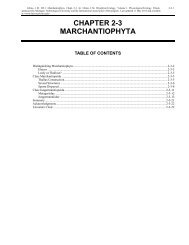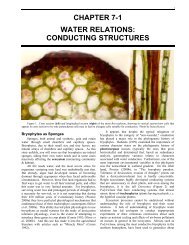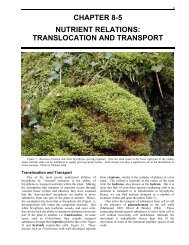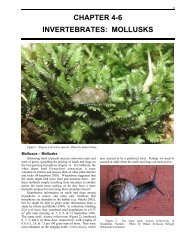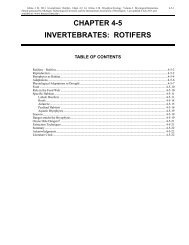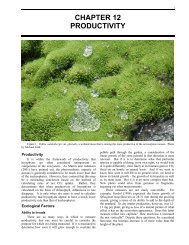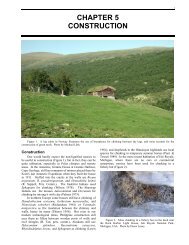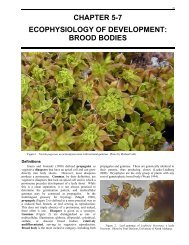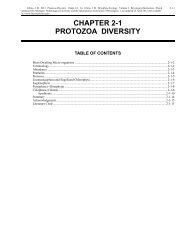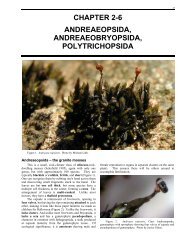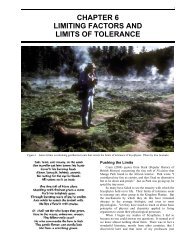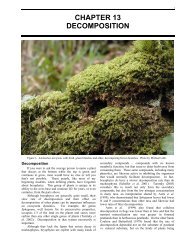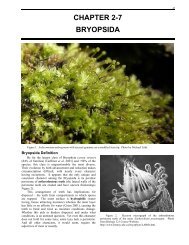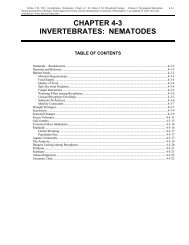108 Chapter 5-9: Ecophysiology <strong>of</strong> Development: Sporophytetransformation <strong>of</strong> the callus into sporangia inPhyscomitrium pyriforme (Bauer 1963). However,<strong>sporophyte</strong> <strong>development</strong> can require environmentalcharacteristics that contrast sharply with those used forgametophyte growth. This permits energy to be divertedinto the <strong>sporophyte</strong>.A case in point is that <strong>of</strong> the moss Physcomitrellapatens. At 15ºC and 8-hour photoperiod (20 µmol m -2 s -1 )– conditions simulating spring – it produced the highestnumber <strong>of</strong> <strong>sporophyte</strong>s in the lab, but at 25ºC and a 16-hourphotoperiod – conditions simulating summer – that numberwas greatly reduced (Hohe et al. 2002). Predictably, thevegetative growth was reduced under conditions favoring<strong>sporophyte</strong> production; one can assume that this was due tonutrient transfer to the developing <strong>sporophyte</strong>. It appearsthat the MADS-box gene PpMADS-S is involved in this<strong>sporophyte</strong> production, as the RNA production associatedwith it was 2-3 times higher during the conditions thatstimulated <strong>sporophyte</strong> <strong>development</strong>.Once fertilization occurs, this one-time egg, nowzygote, continues <strong>development</strong> to look not like its parenttissue, but like a <strong>sporophyte</strong>. What is it that makes tissuebecome <strong>sporophyte</strong> instead <strong>of</strong> gametophyte? True, thereare two sets <strong>of</strong> chromosomes, but there is no new or uniqueinformation in those two sets as opposed to one, onlydifferent combinations and ways <strong>of</strong> expressing genes forthe same type <strong>of</strong> trait. A most striking bit <strong>of</strong> evidenceregarding control <strong>of</strong> <strong>sporophyte</strong> <strong>development</strong> is the ability<strong>of</strong> kinetin to stimulate the production <strong>of</strong> <strong>sporophyte</strong> budson the protonema, at least in Physcomitrium (Menon & Lal1974). But something has to determine that such kinetin isavailable to be the stimulus. Perhaps we can gain someinsight from examining experiments with callus tissue thatinduce it to become gametophyte or <strong>sporophyte</strong> incharacter. Bopp (1968) has elaborated on the physiologicalconditions that determine the life cycle stage developingfrom callus tissue. At concentrations above 1 g/l <strong>of</strong> glucoseonly <strong>sporophyte</strong>s form from <strong>sporophyte</strong> callus. With nosugar, this same <strong>sporophyte</strong> callus produces gametophytes,as does gametophyte callus. The most intriguing andinformative event is that with the addition <strong>of</strong> sugar orcoconut milk, a gametophyte callus will produce<strong>sporophyte</strong>s. Clearly, it is not the kind <strong>of</strong> informationgained by the second set <strong>of</strong> chromosomes that makes thedifference.One can easily imagine how these responses couldrelate to effects <strong>of</strong> surrounding tissues. Isolated cells mustbe self-sufficient in their production <strong>of</strong> glucose, whereas acell (zygote) retained within an archegonium can use theresources <strong>of</strong> the rest <strong>of</strong> the plant. If sugar has already beenmobilized for gametogenesis and fertilization, the zygotecan easily become a target for this resource. In fact, couldit be that the dividing embryo behaves physiologically likea dividing meristem? In tracheophytes, actively dividingcells <strong>of</strong> meristematic regions typically result in themetabolism <strong>of</strong> starch to glucose and the mobilization <strong>of</strong>glucose to the dividing cells. If dividing embryo cells sendthe same message as dividing meristems, one would expectthe same arrival <strong>of</strong> sugars to these cells. Had the zygotebeen shed from the parent plant before the cells began todivide, as is the case in the algae, these food reserves wouldnot have been available.Control <strong>of</strong> GenerationIt is normally the case that the embryo, safely insidethe archegonial tissues and in constant contact with itsparent, will develop into a foot, stalk, and capsule atop thegametophyte. However, in early and cleverly designedexperiments, Pringsheim was able to regenerategametophytic structures from sporophytic tissue (Bryan2001), evidence that the environment, not the duplication<strong>of</strong> genetic information, is the dominant force indetermining what the generation will look like. Thus wecan be certain that the parent tissues are supplying thisspecial environment and most likely influencing the<strong>development</strong> <strong>of</strong> the embryo by controlling moisture, light,nutrients, energy availability, and hormones, at the veryleast.Arnaudow (1925) performed tedious experiments inwhich gametophyte tissue was placed into the archegonium<strong>of</strong> a moss. By doing this, he showed that a gametophyte soplaced could develop the morphological characteristics <strong>of</strong> a<strong>sporophyte</strong>. Meiosis, <strong>of</strong> course, would fail due to the lack<strong>of</strong> pairs unless the moss happened to be polyploid. He thenreversed the procedure and removed zygotes from thearchegonium to develop without the influence <strong>of</strong>gametophyte tissue. These developed into gametophytes.This evidence supports the homology theory that bothgenerations are essentially the same. It is the<strong>development</strong>al environment that differs.Seta ElongationIn liverworts, the capsule forms and then the setaelongates (Figure 2, Figure 3). In mosses, it is the reverse;setae elongate and then the capsule forms (Figure 4, Figure5). In Sphagnum, as well as in some <strong>of</strong> the Bryopsida, theseta fails to elongate. However, unlike the Bryopsida, inSphagnum the gametophyte forms a pseudopodium thatelongates after the capsule matures (Figure 6).Figure 2. Maturing <strong>sporophyte</strong> <strong>of</strong> the leafy liverwortLophocolea heterophylla before seta elongation. Photo by PaulDavison, University <strong>of</strong> North Alabama.
Chapter 5-9: Ecophysiology <strong>of</strong> Development: Sporophyte 109Figure 3. Elongated setae on Lophocolea heterophylla.Photo by Jan-Peter Frahm.Figure 4. Young <strong>sporophyte</strong>s <strong>of</strong> the moss Funariahygrometrica with setae and calyptrae, but no capsules yet. Photoby Michael Lüth.Figure 5. Mature capsules <strong>of</strong> Funaria hygrometrica. Photoby Michael Lüth.Thomas et al. (1970) found that liverwort setaerespond in a manner similar to that <strong>of</strong> stems in higherplants; elongation <strong>of</strong> setae in Lophocolea was promoted bylow concentrations <strong>of</strong> IAA and inhibited at higher ones.Soon after that, Kaufman et al. (1982) determined that cellsin the stalk <strong>of</strong> Conocephalum conicum and seta <strong>of</strong> Pelliaepiphylla exhibited acid growth, much like that <strong>of</strong> Avena(oats), implicating involvement <strong>of</strong> IAA.The pseudopodium (actually gametophyte tissue, notequivalent to a seta) <strong>of</strong> Sphagnum palustre (Figure 6) alsoshows rapid growth in low IAA concentrations (0.01 ppm)but no growth at higher ones (0.5, 1.0 ppm) (Patterson1957). The pseudopodia grows even longer in lowconcentrations than in the controls. But Patterson found apuzzling lack <strong>of</strong> response at any concentration <strong>of</strong> IAA bysetae <strong>of</strong> Frullania inflata and F. tamarisci ssp. asagrayana.Figure 6. Upper: Capsules <strong>of</strong> Sphagnum beforepseudopodium elongation. Photo by Zen Iwatsuki. Lower:Elongated pseudopodia <strong>of</strong> Sphagnum palustre. Photo by JaniceGlime.While comparing the responses <strong>of</strong> two liverworts,Pellia epiphylla (Figure 8) and Conocephalum conicum(Figure 7), to that <strong>of</strong> oats, Kaufman and coworkers (1982)discovered that a tenfold increase in the growth rate <strong>of</strong> oats(Avena) internodes appeared about three hours afterapplication <strong>of</strong> 10 -5 M GA 3 , but that 10 -5 M IAA had noeffect. On the other hand, in the liverworts, the setaeresponded to 10 -5 M IAA with a two-fold increase in growthrate within 10-15 minutes. Thomas et al. (1982)demonstrated the production <strong>of</strong> auxin (IAA) and ethyleneby cells <strong>of</strong> elongating setae <strong>of</strong> Pellia epiphylla, addingmore support to the suggestion that at least IAA mayexercise control over seta elongation, and that mostprobably IAA and ethylene operate in tandem to controlseta growth (Thomas et al. 1983).IAA may play another important role in the seta.Thomas et al. (2002), using radioactively labelled IAA andinfrared video recording <strong>of</strong> Pellia epiphylla setae, haveshown that IAA in donor blocks moved preferentially to thelower sides <strong>of</strong> horizontally placed setae. Upwardgravitropic curvature occurred within 50-60 minutes, whilegrowth rates on the top side <strong>of</strong> the setae dropped (seeFigure 8).



